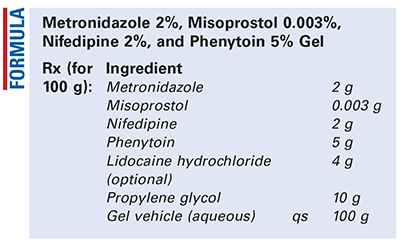US Pharm. 2018;43(6):47-48.

Method of Preparation: Note—Owing to the light sensitivity of some ingredients, use low light and work efficiently.
Calculate the quantity of each ingredient for the amount to be prepared. Accurately weigh or measure each ingredient. Pulverize the tablets—if used—to a fine powder. Mix the powders together until well blended. Add the propylene glycol and mix to form a smooth paste. Geometrically, incorporate the gel vehicle and mix thoroughly after each addition. Package in tight, light-resistant containers and label.
Use: This gel is used in the treatment of skin ulcers and slow-healing open wounds.
Packaging: Package preparation in tight, light-resistant containers.
Labeling: Keep out of reach of children. Protect from light. For external use.
Stability: A beyond-use date of up to 30 days may be used for this preparation.1
Quality Control: Quality-control assessment can include theoretical weight compared with actual weight, specific gravity, active drug assay, color, texture–surface, texture–spatula spread, appearance, feel, rheologic properties, and physical observations.2
Discussion: Metronidazole (C6H9N3O3, MW 171.15) occurs as a white to pale-yellow, odorless, crystalline powder or as crystals. It is stable in air but will darken upon exposure to light. Metronidazole is sparingly soluble in water and alcohol, but only slightly soluble in ether and chloroform. It is used as an antibiotic.1
Misoprostol (Cytotec, C22H38O5, MW 382.53) is a synthetic analogue of prostaglandin E1 (alprostadil) and occurs as a water-soluble, viscous liquid. It is a gastric antisecretory agent with protective effects on the gastroduodenal mucosa and is also known as an antiulcerative agent. Cytotec tablets contain either 100 mcg or 200 mcg of misoprostol. The tablets also contain hydrogenated castor oil, hydroxypropyl methylcellulose, microcrystalline cellulose, and sodium starch glycolate.3
Nifedipine (Adalat, Procardia, C17H18N2O6, MW 346.33) is a 1,4-dihydropyridine-derivative calcium channel blocker used in the management of Prinzmetal (variant) angina and chronic stable angina pectoris, hypertension, Raynaud phenomenon, preterm labor, and acute myocardial infarction. It occurs as a yellow powder that is affected by exposure to light. Nifedipine is practically insoluble in water and soluble in alcohol.1,3
Phenytoin (5,5-diphenylhydantoin, C15H12N2O2, MW 252.27), which is a hydantoin-derivative anticonvulsant, occurs as a white, odorless powder that melts at about 295°C. It is practically insoluble in water and slightly soluble in cold alcohol, chloroform, and ether. Phenytoin has an apparent pKa (acid dissociation constant at logarithmic scale) of 8.06 to 8.33. It should be preserved in tight containers.1,3
Lidocaine hydrochloride (C14H22N2O.HCl.H2O, MW 288.81) is a white, odorless, crystalline powder with a slightly bitter taste. It is an amide-type local anesthetic with a rapid onset and an intermediate duration of action. Lidocaine hydrochloride is highly soluble in water (1:0.7) and in alcohol (1:1.5).2 A 0.5% aqueous solution has a pH in the range of 4.0 to 5.5. Its melting point is in the range of 74C to 79C. Lidocaine hydrochloride is available in both anhydrous and monohydrate forms. Approximately 1.16 g of lidocaine hydrochloride is equivalent to 1 g of lidocaine. Lidocaine hydrochloride should be protected from light.1,3
Propylene glycol (C3H8O2) occurs as a clear, colorless, viscous, practically odorless liquid with a sweet taste, somewhat resembling glycerin. It has a specific gravity of 1.038 g/mL, and it is miscible with acetone, chloroform, 95% ethanol, glycerin, and water. It is not miscible with fixed oils or light mineral oil; however, it will dissolve some essential oils. Propylene glycol is a better solvent than glycerin, and it is similar to ethanol as an antiseptic; it is also used in cosmetics and in the food industry as a vehicle for flavors and emulsifiers. Propylene glycol is stable and may be mixed with numerous other solvents. Since propylene glycol is hygroscopic, it should be stored in an airtight container and protected from light.4
Gel vehicle: Numerous commercial aqueous gel vehicles are available. Otherwise, a vehicle may be prepared from 2% hydroxyethylcellulose in preserved water.
REFERENCES
1. U.S. Pharmacopeia/National Formulary [current revision]. Rockville, MD: U.S. Pharmacopeial Convention, Inc; April 2018.
2. Allen LV Jr. Standard operating procedure for performing physical quality assessment of ointments/creams/gels. IJPC. 1998;2:308-309.
3. McEvoy GK, ed. AHFS Drug Information 2016. Bethesda, MD: American Society of Health-System Pharmacists; 2016:2013-2020,2303-2306,3014-3019,3354-3356.
4. Driver S. Propylene glycol. In: Sheskey PJ, Cook WG, Cable CG, eds. Handbook of Pharmaceutical Excipients. 8th ed. London, England: Pharmaceutical Press; 2017:795-798.
To comment on this article, contact rdavidson@uspharmacist.com.





